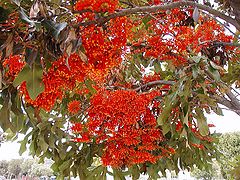Stenocarpus sinuatus
| Stenocarpus sinuatus subsp. var. | Firewheel tree, Queensland firewheel tree | |||||||||||||||||||||||||||||||||||||||||||||||||||||||
|---|---|---|---|---|---|---|---|---|---|---|---|---|---|---|---|---|---|---|---|---|---|---|---|---|---|---|---|---|---|---|---|---|---|---|---|---|---|---|---|---|---|---|---|---|---|---|---|---|---|---|---|---|---|---|---|---|

|
|
| ||||||||||||||||||||||||||||||||||||||||||||||||||||||
| ||||||||||||||||||||||||||||||||||||||||||||||||||||||||
| Standard Cyclopedia of Horticulture |
|---|
|
Stenocarpus sinuatus, Endl. (S. Cunninghamii, Hook., not R. Br.). Tree said to grow to a height of 60-100 ft., glabrous or the infl. minutely tomentose: lvs. petioled, either undivided, oblong-lanceolate and 6-8 in. long, or pinnatifid and over 1 ft. long, with 1-4 oblong lobes on each side, mostly obtuse, quite glabrous, but reddish beneath, penninerved and minutely reticulate: peduncles terminal, either 2 or more together in a general umbel or several at some distance forming a short broad raceme, each peduncle 2-4 in. long, bearing an umbel of 12-20 bright red fls.: perianth 1 in. long; ovary densely pubescent on a glabrous stipe. Austral. CH
|
Cultivation
Propagation
Pests and diseases
Varieties
Gallery
-
photo 1
-
photo 2
-
photo 3
References
External links
- w:Stenocarpus sinuatus. Some of the material on this page may be from Wikipedia, under the Creative Commons license.
- Stenocarpus sinuatus QR Code (Size 50, 100, 200, 500)


